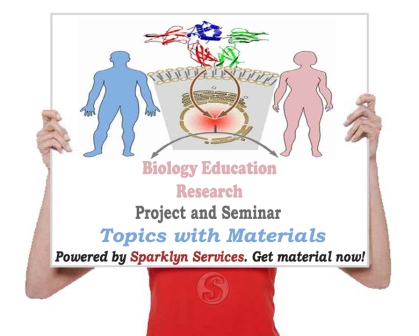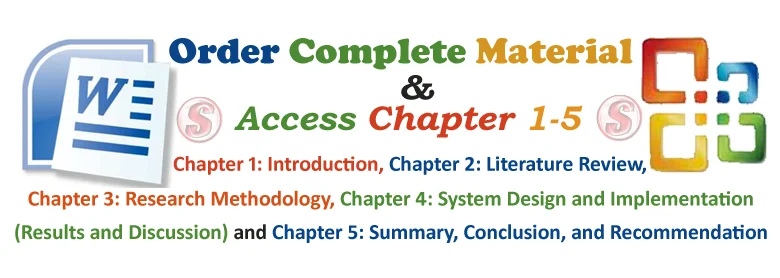1.1 Introduction
Biology as one of the science subject is defined as the study of life and structure of living things. The knowledge of biology helps in checking environmental degradation such as desertification, erosion, water hyacinth, land, air and water pollution (Abugu, 2007). Online biology education is the alternative measures for conventional teaching and learning process in case of future occurrences of any pandemic. Casey (2012) articulated that the use of smart devices has become vital to students because they use them for several purposes not only for those similar to what the Internet provides, but also to explore applications which provide new functions. Users can also get information while surfing on the Internet which helps them to escape from uncomfortable situations. As a result, it seems that many students tend to rely heavily on their mobile phones, which will inevitably lead to even heavier usage (Casey, 2012).
As a prelude to other parts of this study, this chapter will discuss the background upon which this study was initiated, the statement of problems that led to this study, the Aim and Objectives of the study. Others are Significance of the study, Scope of work, Research hypothesis and questions, Limitation of the study and Definition of terms.
1.2 Background of Study
The use of smart devices is gradually becoming a compelling learning tool used to enhance teaching and learning in distance education during Covid-19 Era. Its usage ensures flexible course delivery, makes it possible for learners to access online learning platforms, access course resources and interact digitally. Nowadays, smart devices have become a popular learning system for education especially higher education all over the world because of its multi-functionality characteristic and effectiveness. Nigeria is one of the developing countries of the world where adoption rate of smart devices is very high.
Hong, Chiu and Hhuang (2012) argued that mobile phones are popular among students because they increase their social communication and expand their opportunities for establishing social relationships. Bakare (2018) revealed that undergraduate students in Nigerian Universities make use of their mobile phones to access applications such as Facebook messenger, WhatsApp, Google Talk, MSN, WordPress, and Blogger in accessing Library resources.
As COVID-19 spreads, schools across 153 countries have been shut. This was an unprecedented shock to the education systems around the globe due to interrupted learning as well as delays and cancellations of end of year examinations for many. As of 20 May 2020, about 1.2 billion learners are not able to attend school or university until COVID-19 related restrictions were lifted (Chebib, 2020). Due to the persistence in the spread of the virus, many nations have been engaging the use of smart devices to support teaching and learning. With this sudden paradigm shift away from the classroom in many parts of the globe, some are wondering whether the adoption of online learning will continue to persist post-pandemic, and how such a shift would impact the worldwide education market. Whether it is language apps, virtual tutoring, video conferencing tools, or online learning software, there has been a significant surge in its usage since the emergence of COVID-19.
Belardi (2013) articulated that smart devices and online activities can help students in studying. They can save time when using these tools. But these can also have a bad influence as revealed by 40% of the students that were interviewed. Smart device technology has changed the way of teaching. It enables people to reach out to students more efficiently and effectively through chat groups, video meetings, voting and also document sharing, especially during this pandemic. Students also find it is easier to communicate through the learning app. During the COVID-19 pandemic, the education system of the world has seriously affected. Many countries of the world have to close down their educational institutions to reduce the spread of this virus (Naciri, Baba, Achbani, & Kharbach, 2020).
Going to school is the best public policy tool available to develop skills and potentials, school time can be fun, and from an economic point of view the primary point of being in school is that it increases a child’s ability to become a useful and acceptable member of the society. Even a relatively short time in school has a longer impact in the life of a child; a short period of missed school may have consequences for skill growth in future. This is why individuals cannot estimate how much the COVID-19 interruption will affect biology learning (Samuel, A.I. 2020).
Therefore, in Nigeria where the research was carried out, the activities that was conducted is to know the Use and the Learning Outcome of Smart Devices by Biology Teachers in the Post Covid-19 Era.
1.3 Statement of Problems
Investigation revealed that the closures of schools and universities is said to have impacted over 70% of the world's inhabitants (Aborodeet al, 2020). The school-closure measure means learners previously in school are no longer going to school. The major tasks of higher institutions include teaching, research, and community services that have been disrupted by the COVID-19.
The pandemic also disrupted the academic programmes, examinations, admissions, conferences, workshops and training, graduation programmes of higher institutions. The drastic escalation of coronavirus did not only affect learning, it compounded the pre-existing education inequalities in institutions, with vulnerable and disadvantaged students at the receiving end.
To curb the widening of the existing education inequalities, there is a responsibility on the institution management to put in place measures to ensure continuity, inclusion and equity for all learners during this pandemic. Observation shows that higher institutions either postponed or cancelled all campus events such as graduation ceremonies, workshops, conferences, and other activities. The COVID-19 Pandemic also led to the suspension of the academic calendar of higher institutions.
There is no doubt that students were held on a spot for a period of time. This affected the smooth running of educational sector in the institutions. This study aims to show Investigation revealed that the closures of schools and universities is said to have impacted over 70% of the world's inhabitants (Aborodeet al, 2020). The school-closure measure means learners previously in school are no longer going to school.
The major tasks of higher institutions include teaching, research, and community services that have been disrupted by the COVID-19. The pandemic also disrupted the academic programmes, examinations, admissions, conferences, workshops and training, graduation programmes of higher institutions.
The drastic escalation of coronavirus did not only affect learning, it compounded the pre-existing education inequalities in institutions, with vulnerable and disadvantaged students at the receiving end. To curb the widening of the existing education inequalities, there is a responsibility on the institution management to put in place measures to ensure continuity, inclusion and equity for all learners during this pandemic. Observation shows that higher institutions either postponed or cancelled all campus events such as graduation ceremonies, workshops, conferences, sports (both intra and inter universities), and other activities. The COVID-19 Pandemic also led to the suspension of the academic calendar of higher institutions.
There is no doubt that students were held on a spot for a period of time. This affected the smooth running of educational sector in the institutions. This study aims to show the effect of Online teaching/learning had on the educational life of students.
1.4 Aim and Objectives of Study
The aim of the study is to investigate the Use and the Learning Outcome of Smart Devices by Biology Teachers in the Post Covid-19 Era. In achieving this aim, the following specific objectives were laid out as follows:
- To investigate the challenges faced by undergraduate students when using smart devices for learning;
- To examine the effects of smart devices on students’ academic improvement in the Post Covid-19 Era;
- To identify the various types of smart devices used by Biology Teachers; and
- To examine the integration of smart devices by Biology Teachers in post COVID-19 era teaching and learning among undergraduate students.
1.5 Research Questions
The study came up with research questions so as to be able to ascertain the above stated objectives. The specific research questions for the study are stated below as follows:
- Does the integration of smart devices by Biology Teachers in post COVID-19 era teaching and learning enhance undergraduate student’s academic performance?
- What are the challenges faced by undergraduate students when using smart devices for learning?
- What are the various types of smart devices used by Biology Teachers?
- What are the effects of smart devices on students’ academic improvement in the Post Covid-19 Era?
1.6 Research Hypothesis
In order to pursue the objective of this study, the following generalized statements have been designed to guide and aids in obtaining the result for the experiment to be conducted. For this work, the null hypothesis will be represented with H0 while the alternative hypothesis will be represented with hypothesis H1.
Hypothesis One
- H0: The integration of smart devices by Biology Teachers in post COVID-19 era teaching and learning does not enhance the academic performance of undergraduate students
- H1: The integration of smart devices by Biology Teachers in post COVID-19 era teaching and learning enhances the academic performance of undergraduate students
Hypothesis Two
- H0: There are no issues faced by teachers and students when using smart devices for learning
- H1: There are issues faced by teachers and students when using smart devices for learning
1.7 Significance of Study
The result of the findings would be beneficial to both secondary schools and tertiary institutions as they would know what utilization impact of smart devices on their students and also their academic performance. The study would also be beneficial as they would know what areas to channel the effort to improve the teaching / learning using smart devices to help students and the challenges most of them face during the online (distance) learning.
This study will be of immense benefit to other researchers who intend to know more on this study and can also be used by non-researchers to build more on their research work. This study contributes to knowledge and could serve as a guide for other study.
1.8 Scope of Study
The scope of the research is focused on the Use and the Learning Outcome of Smart Devices by Biology Teachers in the Post Covid-19 Era.
1.9 Limitations of the Study
During the course of this study, many things militated against its completion, some of which are:
- Time Constraint:
The time frame given to accomplish this project was very short due to school academic calendar and it was carried out under pressure which made the researcher not to implement some necessary features.
- Establishment Policies:
Establishment policies posed a serious limitation as most staffs are not ready to release information needed for this research work. There were lots of information needed from the staffs of this establishment to enhance the study which took them time to release or they did not release at all for security purposes, hence the scope was reduced.
- Financial Constraint:
Insufficient fund tends to impede the efficiency of the researcher in sourcing for the relevant materials, literature or information and in the process of data collection (internet, questionnaire and interview).
- Lack of Initial Cooperation from Respondents:
A particular limitation of this work came as a result of the respondent refusal to offer their cooperation at the initial time they were contacted. This contributed in making the success of this research study difficult.
1.10 Definition of Terms
Biology:
It is defined as the study of life and structure of living things. Biology is the study of living things and concerns itself with the study of the structural, behaviour, distribution, the origin of plants, and animals and their relationship with their environment (American Heritage Dictionary of the English Language 2009).
COVID 19:
Coronavirus disease (COVID-19) is an infection which is as a result of a novel severe acute respiratory syndrome coronavirus.
Education:
It is the process of giving systematic instruction especially at a school or university.




